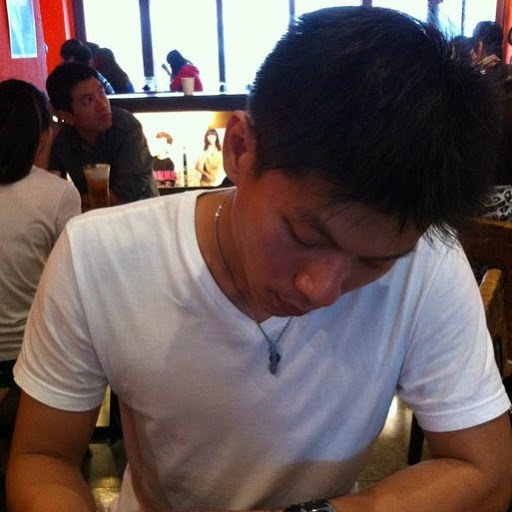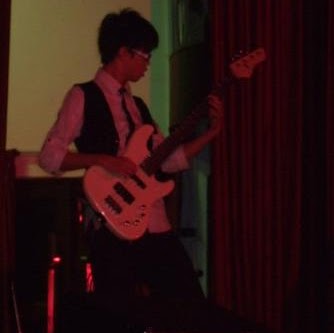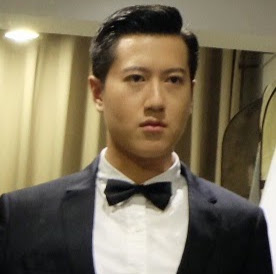Jim Z Huang
age ~41
from Cupertino, CA
- Also known as:
-
- Zixuan Huang
- Xuan Huang Zixuan
- Phone and address:
- 10810 Minette Dr, Cupertino, CA 95014
Jim Huang Phones & Addresses
- 10810 Minette Dr, Cupertino, CA 95014
- 4240 Rondeau Dr, San Jose, CA 95124
- Sunnyvale, CA
- Westford, MA
- Quincy, MA
- Dallas, TX
- Richardson, TX
- Palisades Park, NJ
- Oakland Gardens, NY
Us Patents
-
Bias-Based Mach-Zehnder Modulation (Mzm) Systems
view source -
US Patent:20190190610, Jun 20, 2019
-
Filed:Feb 14, 2019
-
Appl. No.:16/275727
-
Inventors:- Houston TX, US
Jim Huang - Palo Alto CA, US
Ashkan Seyedi - Palo Alto CA, US
Marco Fiorentino - Mountain View CA, US
Raymond G. Beausoleil - Seattle WA, US -
International Classification:H04B 10/50
G02F 1/01
G02F 1/225 -
Abstract:One example includes a bias-based Mach-Zehnder modulation (MZM) system. The system includes a Mach-Zehnder modulator to receive and split an optical input signal and to provide an intensity-modulated optical output signal based on a high-frequency data signal to modulate a relative phase of the split optical input signal to transmit data and based on a bias voltage to modulate the relative phase of the split optical input signal to tune the Mach-Zehnder modulator. The system also includes a bias feedback controller to compare a detection voltage associated with the intensity-modulated output signal with a reference voltage to measure an extinction ratio associated with an optical power of the intensity-modulated optical output signal and to adjust the bias voltage based on the comparison to substantially maximize the extinction ratio.
-
Bias-Based Mach-Zehnder Modulation (Mzm) Systems
view source -
US Patent:20180109322, Apr 19, 2018
-
Filed:May 27, 2015
-
Appl. No.:15/566929
-
Inventors:- Houston TX, US
Jim Huang - Palo Alto CA, US
Ashkan Seyedi - Palo Alto CA, US
Marco Fiorentino - Palo Alto CA, US
Raymond G Beausoleil - Palo Alto CA, US -
International Classification:H04B 10/50
G02F 1/01 -
Abstract:One example includes a bias-based Mach-Zehnder modulation (MZM) system. The system includes a Mach-Zehnder modulator to receive and split an optical input signal and to provide an intensity-modulated optical output signal based on a high-frequency data signal to modulate a relative phase of the split optical input signal to transmit data and based on a bias voltage to modulate the relative phase of the split optical input signal to tune the Mach-Zehnder modulator. The system also includes a bias feedback controller to compare a detection voltage associated with the intensity-modulated output signal with a reference voltage to measure an extinction ratio associated with an optical power of the intensity-modulated optical output signal and to adjust the bias voltage based on the comparison to substantially maximize the extinction ratio.
-
Control Of A Series Pass Circuit For Reducing Singing Capacitor Noise
view source -
US Patent:20160363952, Dec 15, 2016
-
Filed:Jun 11, 2015
-
Appl. No.:14/736908
-
Inventors:- Cupertino CA, US
Nicholas J. Kunst - San Francisco CA, US
Jim Z. Huang - San Jose CA, US -
International Classification:G05F 5/00
H02J 7/00 -
Abstract:A series pass circuit conducts a pass current between a first side and a second side. A power source is coupled to the first side, while a capacitor is coupled to the second side. A system component whose power supply input is coupled to the capacitor may exhibit pulse-type activity. A control circuit increases the resistance to the pass current, in the series pass circuit, in accordance with a reporting signal that indicates whenever the system component is more active or less active. Other embodiments are also described and claimed.
-
Electronic Device With Liquid Contact Sensors
view source -
US Patent:20140253150, Sep 11, 2014
-
Filed:Mar 6, 2013
-
Appl. No.:13/787669
-
Inventors:- Cupertino CA, US
Kevin M. Keeler - Los Gatos CA, US
Jim Z. Huang - Sunnyvale CA, US
Parviz Mishkanian - San Jose CA, US -
Assignee:Apple Inc. - Cupertino CA
-
International Classification:G01R 27/26
G01R 27/02 -
US Classification:324664, 324694
-
Abstract:Electronic devices may be accidentally exposed to liquid during operation. To detect liquid intrusion events, an electronic device may be provided with one or more electronic liquid contact sensors. The liquid contact sensors may have electrodes. Control circuitry may make measurements across the electrodes such as resistance and capacitance measurements to detect the presence of liquid. Liquid contact sensor data may be maintained in a log within storage in the electronic device. The liquid contact sensor data can be used to display information for a user of the electronic device or can be loaded onto external equipment for analysis. Liquid contact sensor electrodes may be formed from metal traces on substrates such as printed circuits, from contacts in a connector, from contacts on an integrated circuit, or from other conductive electrode structures.
Resumes

Senior And Principal Partner Solutions Architect
view sourceLocation:
San Francisco, CA
Industry:
Internet
Work:
Cisco - San Jose, California since Jul 2012
Senior Manager, Cloud and Systems Management Technology Group
Cisco Emerging Business Group - San Jose, CA Jan 2006 - Jun 2012
Senior Manager, Software Development
Cisco Internet Technology Division - San Jose, CA Mar 2000 - Dec 2005
Manager, High Availability Group
Honeywell Technology Center - San Jose, CA Jan 1991 - Feb 2000
Staff Member
Senior Manager, Cloud and Systems Management Technology Group
Cisco Emerging Business Group - San Jose, CA Jan 2006 - Jun 2012
Senior Manager, Software Development
Cisco Internet Technology Division - San Jose, CA Mar 2000 - Dec 2005
Manager, High Availability Group
Honeywell Technology Center - San Jose, CA Jan 1991 - Feb 2000
Staff Member
Education:
University of Massachusetts, Amherst 1991
Ph.D., Computer Engineering, Real-time Transaction Processing
Ph.D., Computer Engineering, Real-time Transaction Processing
Skills:
Cloud Computing
Distributed Systems
Cisco Technologies
High Availability
Cross Functional Team Leadership
Program Management
Networking
Linux
Embedded Systems
Operating Systems
Switches
Cisco Systems Products
Rtos
Architecture
Virtualization
Data Center
Ip
People Skills
Project Management
Communication Protocols
Project Planning
Quality Assurance
Enterprise Software
Distributed Systems
Cisco Technologies
High Availability
Cross Functional Team Leadership
Program Management
Networking
Linux
Embedded Systems
Operating Systems
Switches
Cisco Systems Products
Rtos
Architecture
Virtualization
Data Center
Ip
People Skills
Project Management
Communication Protocols
Project Planning
Quality Assurance
Enterprise Software
Certifications:
Aws Solutions Architect - Associate
Aws Solutions Architect - Professional
Aws Solutions Architect - Professional

It Manager
view sourceLocation:
San Jose, CA
Industry:
Information Technology And Services
Work:
It Manager

Director, Operations
view sourceIndustry:
Computer Hardware
Work:
Istor Networks, Inc.
Director, Operations
Director, Operations

Iphone Senior Hw System Engineer
view sourceLocation:
4240 Rondeau Dr, San Jose, CA 95124
Industry:
Consumer Electronics
Work:
Apple - Cupertino, CA since Mar 2012
iPhone HW Systems Engineer
Draper Laboratory - Cambridge, MA Jun 2010 - Mar 2012
Analog/Mixed Signal IC Design Engineer
Texas Instruments Jun 2006 - Nov 2009
Test Development Engineer
iPhone HW Systems Engineer
Draper Laboratory - Cambridge, MA Jun 2010 - Mar 2012
Analog/Mixed Signal IC Design Engineer
Texas Instruments Jun 2006 - Nov 2009
Test Development Engineer
Education:
MIT 2011 - 2014
The University of Texas at Dallas 2008 - 2010
M.S.E, Elec. Engr - Circuits/Systems University of Michigan 2002 - 2006
B.S.E, Electrical Engineering
The University of Texas at Dallas 2008 - 2010
M.S.E, Elec. Engr - Circuits/Systems University of Michigan 2002 - 2006
B.S.E, Electrical Engineering
Skills:
Mixed Signal
Pcb Design
Debugging
Power Management
Analog
Analog Circuit Design
Semiconductors
Low Power Design
Hardware Architecture
Integrated Circuit Design
Electronics
Perl
Ic
Circuit Design
Verilog
Ldo
Cmos
Simulations
Firmware
Cadence Virtuoso
Systemverilog
Pcb Design
Debugging
Power Management
Analog
Analog Circuit Design
Semiconductors
Low Power Design
Hardware Architecture
Integrated Circuit Design
Electronics
Perl
Ic
Circuit Design
Verilog
Ldo
Cmos
Simulations
Firmware
Cadence Virtuoso
Systemverilog
Languages:
English
Mandarin
Mandarin

Jim Huang
view source
Jim Huang
view source
Provider Services Representative
view sourceWork:
Provider Services Representative

Jim Huang
view sourceName / Title
Company / Classification
Phones & Addresses
Manager
OMNISECURE.COM
Computer Processing and Data Preparation and ...
Computer Processing and Data Preparation and ...
1250 Aviation Ave # 250K, San Jose, CA 95110
Website: omnisecure.com
Website: omnisecure.com
Manager
OMNISECURE.COM
1250 Aviation Ave #250K, San Jose, CA 95110
(408)2931830
(408)2931830
President
URG INTERNATIONAL INC
257 Castro St #210, Mountain View, CA 94041
President
USC TOBACCO CORP
257 Castro St STE 210, Mountain View, CA 94041
Isbn (Books And Publications)

Classmates

Jim Huang
view sourceSchools:
Peabody Elementary School Cambridge MA 1991-1995, Jonas Clarke Middle School Lexington MA 1995-1997

Jim Huang
view sourceSchools:
Brentwood College Mill Bay Saudi Arabia 2000-2004
Community:
Derek Arnoldi, Jeremy Etherington, John Yaryan, David Howe

Irvington Elementary Scho...
view sourceGraduates:
Ray James (1983-1987),
Amy Flores (1979-1983),
James Huang (1987-1991),
Nguyen Joanne (1974-1978),
Dennis Smith (1976-1980),
Evan Hart (1988-1992)
Amy Flores (1979-1983),
James Huang (1987-1991),
Nguyen Joanne (1974-1978),
Dennis Smith (1976-1980),
Evan Hart (1988-1992)

Brentwood College, Mill b...
view sourceGraduates:
James McBride (2001-2005),
Jim Huang (2000-2004),
Cameron Hunter (1980-1984),
Anna Hugel (1979-1980)
Jim Huang (2000-2004),
Cameron Hunter (1980-1984),
Anna Hugel (1979-1980)

San Jose State University...
view sourceGraduates:
James Huang (1996-2002),
Enrique Aceves (1992-1997),
Rob Nath (1989-1993),
Alfonso Torres (1974-1978),
Gary Corsiglia (1972-1974),
Syed Shah (1992-1996)
Enrique Aceves (1992-1997),
Rob Nath (1989-1993),
Alfonso Torres (1974-1978),
Gary Corsiglia (1972-1974),
Syed Shah (1992-1996)

Country Day School, St. l...
view sourceGraduates:
James Huang (1985-1989),
Rodney Schiffer (1983-1987),
Kishan Ballal (1988-1992),
Robert Mrazik (1977-1981)
Rodney Schiffer (1983-1987),
Kishan Ballal (1988-1992),
Robert Mrazik (1977-1981)

Washington University - E...
view sourceGraduates:
James Huang (1987-1991),
Dave Wombacher (1973-1976),
Dionysios Patakas (1984-1988),
Stephen Hoyt (1955-1959)
Dave Wombacher (1973-1976),
Dionysios Patakas (1984-1988),
Stephen Hoyt (1955-1959)
Youtube
Flickr
Plaxo

Jim Huang
view source
Jim Huang
view sourceAssociate Director at CME Group

Jim Huang
view sourceChief engineer at PLDS
Googleplus

Jim Huang
Education:
UMUC, Oklahoma City University - MSA

Jim Huang
Education:
University of California, Riverside, Shandong University

Jim Huang
Work:
Elisjones & Associates P/L - Accountant (2005)
Education:
University of New South Wales - Information Technology

Jim Huang
Education:
Ashland University - Computer science
Tagline:
I like cookies with milk.....

Jim Huang

Jim Huang
Work:
0xlab - Developer
Bragging Rights:
苟活到三十歲

Jim Huang

Jim Huang

Jim Huang
view source
Jim Huang
view source
Jim Huang
view source
Jim Huang
view source
Jim Huang
view source
Jim Huang
view source
Jim Huang
view source
Jim Huang
view sourceGet Report for Jim Z Huang from Cupertino, CA, age ~41













